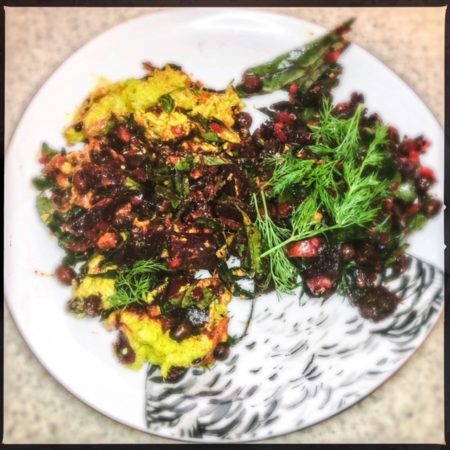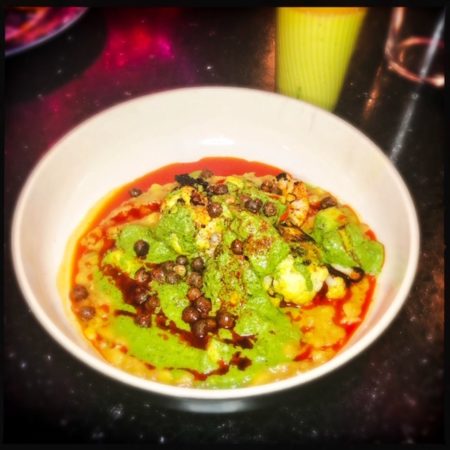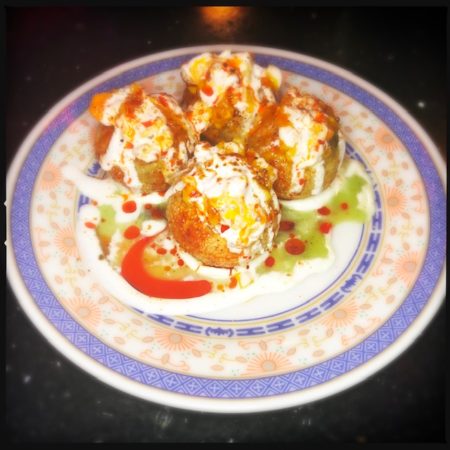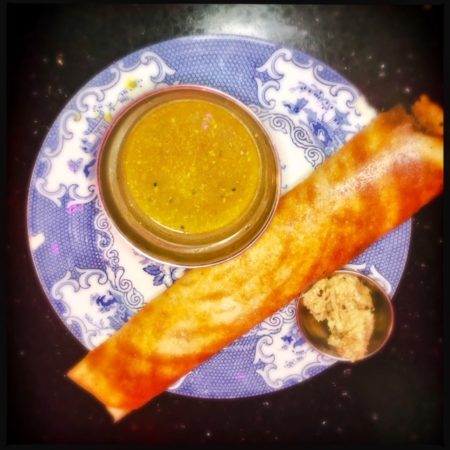Tu expertly delves into the cuisine of the Indian subcontinent (Charleston City Paper)

Sitting in Tu 2.0’s dark middle room, with strings of colorful Christmas lights and a club version of Bieber’s “What do you Mean?” pulsating overhead, I find myself fabricating an imaginary conversation between co-owners Joey Ryan and husband/wife team Josh Walker and Duolan Walker-Li.
“Sure, people love the WTFery, but I think we should revamp Tu.”
“Double up on cheese ice production? Hang some additional strands of lights? What do you mean?”
“I mean a total 180 on the menu. Take a page from XBB and pump up the volume on a complex culinary region. I’m thinking India.”
“The subcontinent!? But we have a human infant to consider!”
“Exactly.”
[Nods head yes, but wants to say no.]
“I tell you what, let’s only open up on Thursday, Friday and Saturday. That’ll keep them guessing.”
And behold, the era of Tu 2.0 is upon us. What a moment in time it is.

The new dinner menu (with Indian dishes subject to change ) is divided into chaats and snacks, breads, and shared plates, but with nary a warming tray in sight, don’t expect the typical buffet standbys like biryani rice or tandoori chicken here. Along with their take on the relatively familiar samosa ($10), the pani puri ($9) delivers an East Indian street food rarely found outside the crowded sidewalks of Kolkata. Rather, puri — small Indian flatbreads that puff when fried — are filled with garam masala-infused garbanzo beans. Served cold, the four donut hole-sized snacks are topped with a sweet mango chutney, spicy chili oil, and a white sauce that is at once salty and coconutty. Messy and flavorful, it’s an apropos hint of the complexities to come.
The beet chaat ($10) beat out some stiff competition to reign as Favorite Dish of Them All. This vegetarian, perhaps even vegan, concoction is loaded with taste and texture, packing in more flavor than your average beast-based bite. The tiny cubes of tender beets are intermixed with crisp, crunchy fried peas, and then topped with raw, tender kale and fronds of fresh dill. Finished with a cashew chutney resplendent with cumin and reminiscent of a smooth falafel, it’s a dish that’s at once creamy, crunchy, sweet, and herbal.
Tu 2.0’s naan flatbread comes in three varieties, plain ($4.50), garlic ($5), and cheesy garlic ($5.50). The first arrives brushed with butter and is sprinkled with coarse salt. Roughly 10 inches across, it’s thick and chewy — a little bit breadier than some — with a slight sourdough flavor. Notably hearty, it’s a good vehicle for the three spreads ($15 for all three.)
The raita ($7), a yogurt-based condiment intended to cool a burning palate, is typically made with cucumber, cumin, and mint. The version available during my visit was a thick squash and pumpkin variety. Filled with grated gourd, it’s thick and bland, which for some may offer a welcome respite from the otherwise impassioned flavors.

The brinjal ($8), a traditional eggplant chutney, is topped with pickled raisins and mustard seeds. The Indian name for eggplant, the brinjal itself takes a backseat to the accompanying notes of tamarind, ginger, garlic, and coriander. Simple and straightforward, I found this preferable to the raita, yet would elect only the daal ($7) if given a do-over. Thick and spicy, it’s fairly by-the-book, with delicate notes of coconut in the finish.
On the shared dishes side of things, the makhani murgh ($15) is the restaurant’s take on what’s more commonly called butter chicken. Perhaps due to the near-blackout conditions in the middle dining room, it came as a surprise to find that the boneless cuts of poultry had been left skin-on, and by and large, said skin had liberated itself from the meat. This resulted in several mouthfuls of nothing but flabby chewiness — not my thing. Bathed in a fragrant, but extremely salty yogurt-based sauce, the blast of fiery chili heat at the finish may be too much for some palates. Served with a small, lackluster dish of basmati rice ($3) there are better options to be had.
Those missing the old Tu might be happy to learn that the cocktail menu is unchanged. Thus, it still offers the Monaco ($12), made with rye, Campari, and orange oil, plus bitter, artichoke-derived Cynar digestivo; as well as the distinctively named and far-less-pungent Leather Nun ($12), crafted with dark rums, blackberry liqueur, and fresh lemon juice.
Tu 2.0 still occupies the same ‘old meets new’ Charleston single on Meeting Street. Seated in the middle room, three servers busted their butts, hurriedly emerging from and disappearing behind the black curtains on the wall of the disco-themed room. For their part, service is prompt, informed, and inconspicuous.
Equally so, some of the food. In the darkness, I assumed the green-cloaked squares in the gobi ($13) were chunks of avocado, but nope. It’s tart green apple, which results in a dish that’s at once piquant, fresh, and unusual. Florets of grilled cauliflower add a meatiness, which is further punctuated by chili oil. Similar to the crisp peas in the beet chaat, the fried lentils here provide a delightful pop of crunch.
Last up, the dosa ($10) is not to be missed. The crisp, savory pancake is as greasy as a donut, but in the best possible way. Filled with a velvety, slightly spicy cheese mixture, the crusty lentil and rice-based crepe is in perfect contrast. Served with a delicate coconut chutney with a sweet heat finish, plus a small bowl of sambar — a South Indian lentil stew — every bite is a treat.

While Tu is the informal of “you” in French, Italian, and Spanish, the name was actually inspired by its context in Mandarin Chinese. As chef Walker once explained, “It means Earth, and the character for it is basically the opposite of the character for heaven, kind of like ‘everything under heaven.'”
While entirely suitable for the former “dafuq?” menu, a name change may be something to consider for this new incarnation. On that note, behold a smattering of ideas inspired by the restaurant’s eclectic Madonna, Rihanna, and “Mambo No. 5”-filled soundtrack:
“Poppadum Preach”
“Spice, Spice Baby”
“Raj Against the Machine”
“Et Tu, Vishnu?”
The last of which, I really hope they’ll consider. In return, I request nothing more than the recipe for the beet chaat.T






